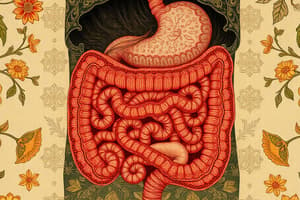Podcast
Questions and Answers
What is the smallest unit of life?
What is the smallest unit of life?
- Cell (correct)
- Tissue
- Organism
- Organ
Which type of tissue serves to connect, support, and protect other types of tissue?
Which type of tissue serves to connect, support, and protect other types of tissue?
- Nervous tissue
- Muscle tissue
- Epithelial tissue
- Connective tissue (correct)
What is the function of adipose tissue?
What is the function of adipose tissue?
- Transports nutrients and oxygen
- Covers and lines organs
- Stores energy and insulates the body (correct)
- Supports the skeleton
Which of the following best describes blood tissue?
Which of the following best describes blood tissue?
What is the extracellular matrix?
What is the extracellular matrix?
Which type of connective tissue is involved in the formation of cartilage?
Which type of connective tissue is involved in the formation of cartilage?
What appearance does adipose tissue have under a microscope?
What appearance does adipose tissue have under a microscope?
Which type of tissue would you find in tendons and ligaments?
Which type of tissue would you find in tendons and ligaments?
What is the primary function of bone tissue?
What is the primary function of bone tissue?
Which type of epithelial tissue forms protective barriers?
Which type of epithelial tissue forms protective barriers?
What characterizes cardiac muscle tissue under the microscope?
What characterizes cardiac muscle tissue under the microscope?
Which of the following accurately describes smooth muscle tissue?
Which of the following accurately describes smooth muscle tissue?
What is the role of neurons in nervous tissue?
What is the role of neurons in nervous tissue?
What is unique about glandular epithelium?
What is unique about glandular epithelium?
Which tissue type connects and supports different body structures?
Which tissue type connects and supports different body structures?
Which function is NOT vital for living organisms?
Which function is NOT vital for living organisms?
Study Notes
Levels of Organization in Biology
- The smallest unit of life is a cell.
- Cells combine to form tissues.
- Tissues combine to form organs.
- Organs work together to form organ systems.
- Organ systems work together to form an organism.
Types of Tissues
- Four types of tissues exist: connective tissue, muscle tissue, nervous tissue, and epithelial tissue.
Connective Tissue
- Connective tissue consists of different types of cells immersed in a gel-like substance called the extracellular matrix.
- Functions: connects, supports, and protects other types of tissue.
- Examples: Connective tissue proper, Adipose tissue, Cartilaginous tissue, Blood tissue, Bone Tissue.
Connective Tissue Proper
- Function: Connects, supports, and protects other types of tissue.
- Examples: Dermis, tendons, and ligaments.
Adipose Tissue
- Function: Stores energy in the form of lipids in cells called adipocytes.
- Example: Helps to cushion and insulate the body.
- Under a microscope, it appears as white, round spaces divided by lines.
Cartilaginous Tissue
- Function: Supports the skeleton by forming cartilage.
- Example: Under a microscope it appears as gruyere cheese.
- Contains chondrocytes.
Blood Tissue
- Function: Transports nutrients, oxygen, and waste products.
- Example: Also involved in blood clotting and the immune response.
Bone Tissue
- Function: Forms bones and supports the body.
- Example: Under a microscope, the rings of a tree are present.
Epithelial Tissue
- Epithelial cells are tightly packed together to form barriers between the body and the external environment and between distinct internal environments within the body.
- Examples: Covering Epithelium and Glandular Epithelium
Covering and Lining Epithelium
- Function: Covers the outside of the body (epidermis) and lines internal cavities (mucous membranes of the digestive tract and endothelium of the blood vessels).
- Example: Under a microscope, cells usually have a cubic shape with a clear nucleus.
Glandular Epithelium
- Function: Contains secretory cells that combine to form glands.
- Example: Glands are organs that secrete substances such as hormones and sweat.
- Under a microscope, the gland is shown as a clear space in the epithelium.
Nervous Tissue
- Function: Transmits nerve impulses.
- Example: Consists of specialized branch-like cells called neurons.
- Neurons are protected by neuroglia cells that also provide necessary nutrients.
Muscle Tissue
- Function: Muscle tissue is formed by cells called myocytes that are able to contract.
- Examples: Cardiac muscle tissue, Skeletal muscle tissue, and Smooth muscle tissue.
Cardiac Muscle Tissue
- Function: Makes up the heart muscle.
- Example: This tissue contracts involuntarily and quickly, and is responsible for the heartbeat.
- Under a microscope, the cells look striated and with a single nucleus.
Skeletal Muscle Tissue
- Function: Makes up the muscles that cover the skeleton.
- Example: Under a microscope, the cells look striated and with more than one nucleus.
Smooth Muscle Tissue
- Function: Responsible for the movements of the intestines and other organs.
- Example: Under a microscope, the cells are not striated, and with one nucleus.
Organ Systems
- We need nutrition, interaction, and reproduction for living.
- To perform these three vital functions, we need energy.
- Every cell in our body needs energy.
- The energy formula:
- This is not provided in the text, and may be explored in a different learning situation.
Studying That Suits You
Use AI to generate personalized quizzes and flashcards to suit your learning preferences.
Related Documents
Description
Explore the foundational concepts of the levels of organization in biology, from cells to organisms. This quiz covers the different types of tissues, particularly connective tissue and its functions. Test your knowledge on how these structures work together to maintain life.




